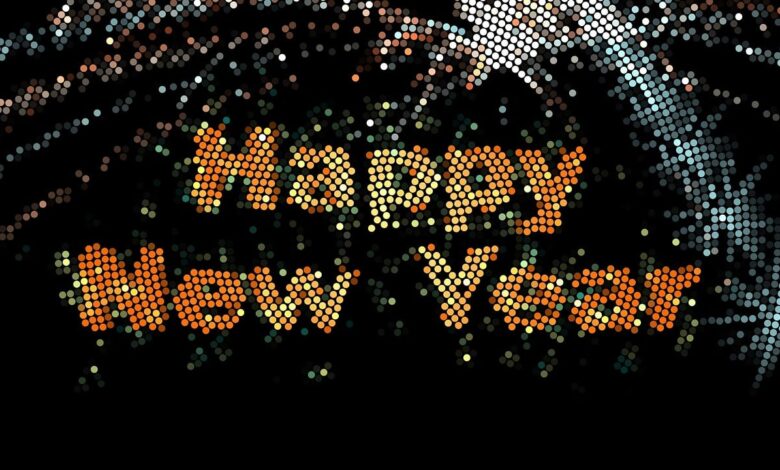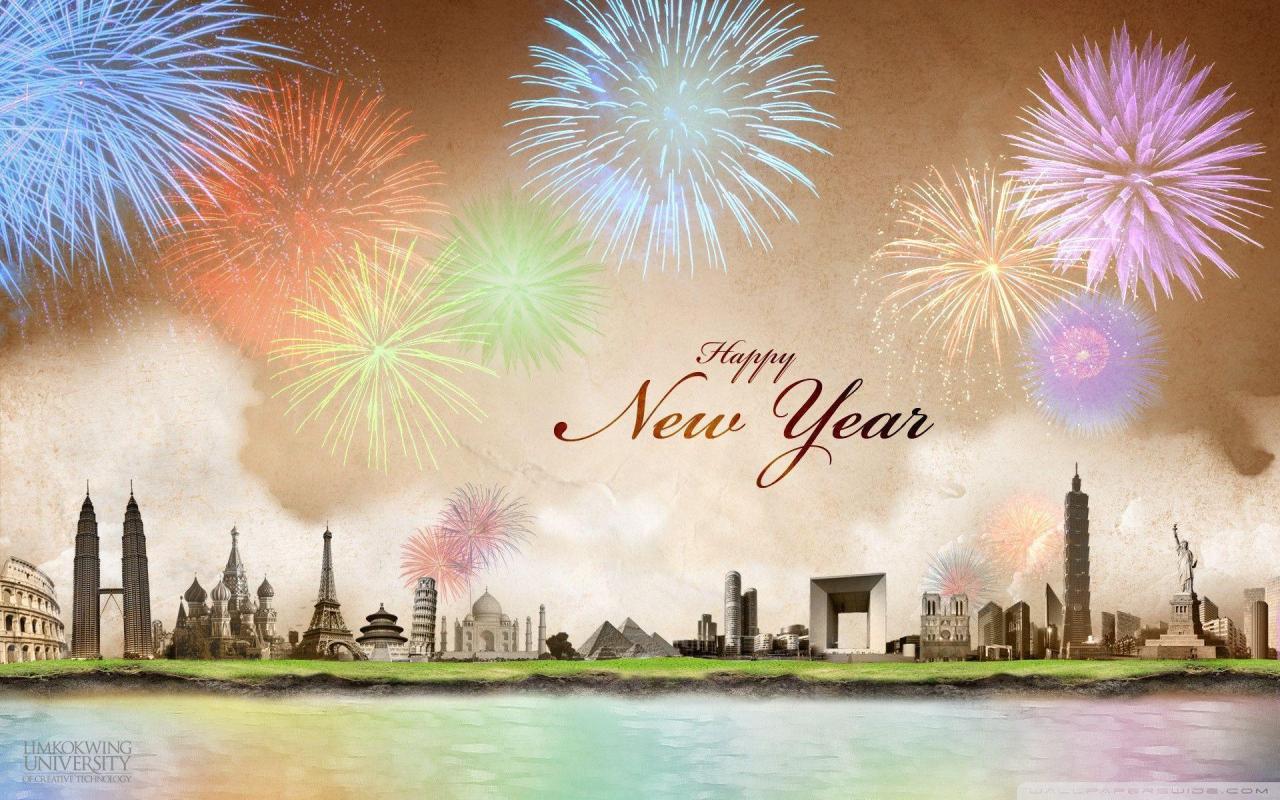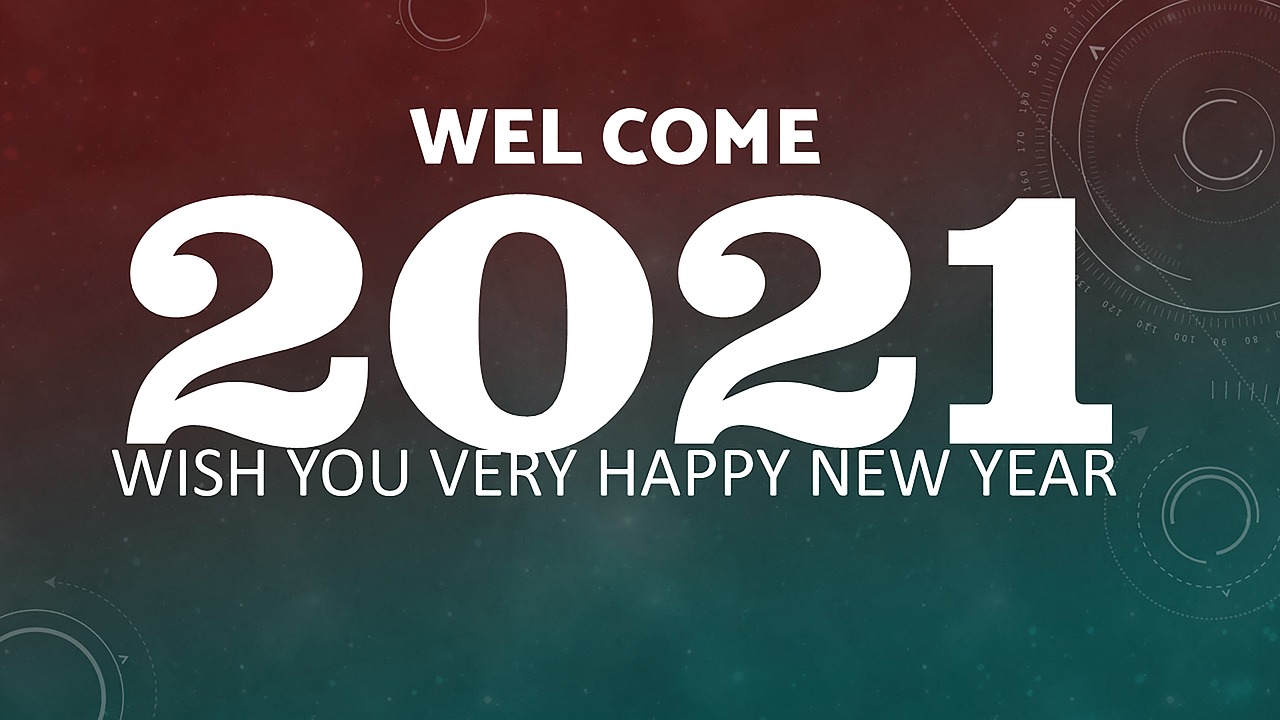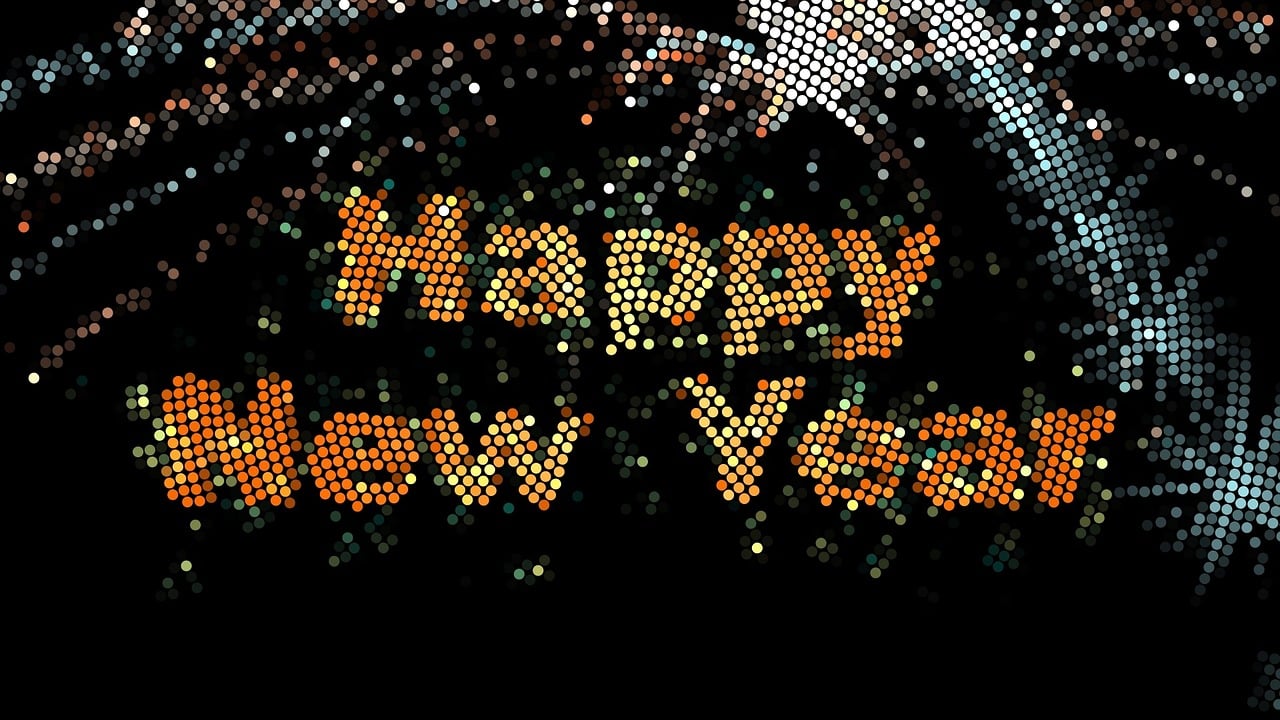
Free Happy New Year Images A Guide
Free Happy New Year images – finding the perfect festive visuals for your projects can be a real headache! This post dives deep into the world of free New Year’s images, exploring where to find them, how to use them legally, and how to make them shine. We’ll cover everything from understanding image licenses to optimizing your images for web use and even touch on the ethical considerations involved.
Get ready to elevate your New Year’s celebrations with stunning, legally sound imagery!
We’ll unpack the nuances of different image repositories, comparing licensing options and image quality. We’ll also look at current design trends and how to create a modern, impactful image. Finally, we’ll cover best practices for using these images across various platforms, ensuring your New Year’s greetings are both visually appealing and ethically sound. So grab your eggnog, settle in, and let’s explore the wonderful world of free Happy New Year images!
Image Sources and Licensing
Finding the perfect free images for your Happy New Year greetings is crucial, especially if you’re creating content for a blog or social media. Using copyrighted images without permission can lead to legal issues and damage your reputation. Understanding image licensing is key to avoiding these problems. This section will explore several free image repositories and their licensing terms.
Free image repositories offer a vast selection of images, but the licensing terms vary significantly. Knowing the differences between licenses like Creative Commons and royalty-free is essential for responsible usage. Misunderstanding these licenses can result in unintentional copyright infringement, even if the images are labeled as “free.”
Free Image Repositories and Their Licensing
Choosing the right image repository depends on your specific needs and the level of creative freedom you require. Many sites offer high-quality images under various licenses, making it possible to find suitable options for both personal and commercial use. However, always double-check the license before using any image.
Comparison of Image Repositories
The following table compares four popular free image repositories, highlighting their licensing options and typical image quality. Remember that image quality can vary within each repository, and this table reflects general observations.
| Repository Name | License Type | Image Quality | URL (optional) |
|---|---|---|---|
| Unsplash | Creative Commons Zero (CC0)
|
Generally high-resolution and professionally shot | unsplash.com |
| Pexels | Creative Commons Zero (CC0)
|
High-quality images, diverse range of subjects | pexels.com |
| Pixabay | Creative Commons Zero (CC0)
|
Wide variety of images, quality varies | pixabay.com |
| Flickr (Creative Commons Search) | Various Creative Commons licenses (CC BY, CC BY-SA, etc.) | Quality varies widely, depending on the photographer | flickr.com |
Implications of Different Licenses
Using images under different licenses has distinct implications. For instance, images under a Creative Commons Zero (CC0) license are essentially in the public domain, meaning you can use them without attribution. However, Creative Commons licenses like CC BY require attribution to the original creator, while others might restrict commercial use or require sharing under the same license.
Royalty-free images often require a one-time payment for usage rights, but they typically grant broader usage permissions than many Creative Commons licenses. Always carefully review the specific license terms before using any image. Failure to comply with the license terms can result in copyright infringement.
Image Characteristics and Trends
Free Happy New Year images typically share a common visual language, evolving subtly year to year. Understanding these characteristics helps designers create effective and appealing designs, and also helps users find exactly what they’re looking for.Free Happy New Year images commonly utilize bright, celebratory colors. Think deep reds, shimmering golds, vibrant greens, and sparkling blues. These colors evoke feelings of joy, festivity, and warmth, aligning perfectly with the holiday spirit.
Font choices often lean towards elegant serif fonts for a classic feel or playful sans-serif fonts for a modern touch. Themes consistently revolve around celebratory elements like fireworks, champagne glasses, glittering confetti, and festive decorations. Abstract designs incorporating these elements are also prevalent, offering a more minimalist approach.
Typical Visual Elements in Free Happy New Year Images
The visual elements found in these images are strongly tied to the overall celebratory mood. Common elements include stylized numbers representing the new year, often prominently displayed. Illustrations of fireworks bursting in vibrant colors are frequently featured, capturing the excitement and energy of the occasion. Abstract patterns mimicking confetti or sparkles add a sense of dynamism and celebration.
Simple, elegant text expressing “Happy New Year” or similar greetings are consistently included, ensuring clear messaging. The use of festive imagery, such as snowflakes, Christmas trees (depending on the date), and other winter-themed visuals, are also common. The overall aesthetic aims to create a visually appealing and emotionally resonant image.
Current Design Trends in New Year’s Imagery
Current trends in New Year’s imagery showcase a move towards both minimalist and maximalist approaches. Minimalist designs often utilize a limited color palette, clean lines, and negative space to create a sophisticated and modern feel. Maximalist designs, conversely, embrace bold colors, intricate patterns, and a multitude of decorative elements to convey a sense of exuberance and festive overload.
Geometric patterns, especially those incorporating circles and triangles, are increasingly popular, adding a modern touch to traditional imagery. The use of gradients and subtle texture overlays also adds depth and visual interest. A strong trend involves the integration of 3D elements and realistic textures, giving the images a more tactile and immersive feel.
Innovative and Unique Approaches to New Year’s Image Design
Innovative approaches frequently incorporate unexpected elements or reinterpret traditional symbols. For example, instead of typical fireworks, some designs feature abstract representations of light and energy, creating a more modern and less literal interpretation of the celebration. Other unique approaches involve the use of unexpected color palettes, such as muted pastels or earthy tones, to create a more sophisticated or unconventional mood.
The incorporation of hand-drawn elements or artistic textures can also add a unique, personalized touch. Some designers focus on creating interactive or animated images, adding another layer of engagement for the viewer. The use of AR (augmented reality) elements within images is also a burgeoning trend, offering unique interactive experiences.
Hypothetical Modern New Year’s Image Design
Imagine a square image dominated by a large, stylized “2024” rendered in a bold, sans-serif font. The numbers are a gradient of deep teal transitioning to a vibrant emerald green, creating a sense of depth and movement. The background is a subtle, textured gradient of midnight blue fading into a deep indigo. Subtle, geometric shapes in shimmering gold are scattered across the background, creating a sense of understated sparkle.
The composition is centered, with the “2024” taking center stage. Small, almost invisible confetti-like elements are subtly animated, adding a subtle sense of movement and energy. The overall aesthetic is modern, sophisticated, and quietly celebratory, avoiding the clichés of overly bright colors and gaudy decorations. The color palette is cool and calming, yet still festive, creating a visually appealing yet sophisticated design.
Image Usage and Applications

Source: pixelstalk.net
Free Happy New Year images find widespread use across a variety of digital and physical platforms, enhancing greetings and adding festive cheer to communications. Their accessibility makes them a valuable asset for both personal and professional use, boosting engagement and conveying seasonal warmth. The versatility of these images allows for creative applications tailored to specific audiences and platforms.Free Happy New Year images are incredibly versatile.
They enhance websites by adding a celebratory atmosphere to homepages, banners, and social media integration points. On social media, they instantly convey the celebratory spirit, making posts more engaging and shareable. They’re also perfect for creating personalized e-cards, printed greetings, and even promotional materials for businesses. The choice of image will depend heavily on the specific application and intended audience.
Need some festive cheer for your YouTube channel? Finding free Happy New Year images is a breeze, and they’re perfect for creating eye-catching thumbnails. To really boost your video’s visibility, though, check out this awesome guide on getting it on with YouTube – it’s packed with tips! Then, use those amazing free Happy New Year images to make your videos pop even more.
Effective Image Placement and Integration in Different Digital Platforms
Strategic placement is key to maximizing the impact of Happy New Year images. On websites, consider using a high-quality image as a hero image on the homepage, subtly integrated into sidebars, or as part of a festive header. Social media platforms benefit from images optimized for each platform’s specific dimensions. For example, a square image works well on Instagram, while a wider image is better suited for Facebook or Twitter.
Email newsletters can feature images as headers or within the body, enhancing visual appeal and adding a personal touch. Remember to ensure the image is appropriately sized and doesn’t slow down loading times.
Best Practices for Using Free Images in Online and Offline Contexts
- Attribution: Always check the license and attribute the creator appropriately, following the guidelines provided. This respects the creator’s work and avoids copyright infringement.
- Image Quality: Prioritize high-resolution images for crisp, clear visuals, especially for print media. Low-resolution images will appear blurry and unprofessional.
- Relevance: Select images that align with the overall theme and message. A poorly chosen image can detract from the intended impact.
- Context: Ensure the image complements the surrounding content, rather than clashing with it aesthetically or thematically.
- Accessibility: Consider the accessibility of the image for users with visual impairments. Provide alternative text descriptions for screen readers.
- File Size: Optimize image file size to ensure fast loading times on websites and in emails. Larger files can significantly impact user experience.
Examples of Free Happy New Year Image Use in Social Media Posts
The following examples illustrate effective integration of free Happy New Year images across various social media platforms:
- Instagram Post: A square image featuring a minimalist design of gold confetti falling on a dark background, accompanied by a short, celebratory caption. This post would leverage Instagram’s visual focus and appeal to a broad audience.
- Facebook Post: A wider image depicting a vibrant fireworks display over a city skyline, paired with a longer caption expressing New Year’s wishes and company updates (if applicable). This approach works well on Facebook due to the platform’s allowance for longer captions and varied image formats.
- Twitter Post: A smaller, more concise image of a simple New Year greeting card design, coupled with a brief and impactful message wishing followers a happy new year. Twitter’s character limits necessitate a more compact approach.
- LinkedIn Post: A professional-looking image featuring a stylized graphic of a rising sun or upward-trending graph, symbolizing new beginnings and professional success, along with a thoughtful reflection on the past year and aspirations for the future. This caters to the professional nature of the platform.
Image Quality and Optimization: Free Happy New Year Images

Source: pixabay.com
Creating stunning Happy New Year images is only half the battle; ensuring they load quickly and look great on any device is just as crucial. High-quality images are essential for attracting viewers and creating a positive brand experience, while optimized images ensure a smooth user experience, particularly vital on websites and social media. This section dives into the specifics of achieving both.Image resolution directly impacts the visual appeal and usability of your New Year’s images.
High-resolution images, measured in pixels (e.g., 3000×2000 pixels), provide sharp details and clarity, crucial for print media, large format displays, or high-resolution screens. Low-resolution images (e.g., 640×480 pixels), on the other hand, appear blurry and pixelated when enlarged, diminishing their visual impact. Using high-resolution images ensures your New Year’s greetings look stunning regardless of how they are used.
Image File Size Optimization Techniques
Optimizing image file size is crucial for fast loading times. Large images significantly slow down website performance, leading to frustrated users and potentially impacting . Several techniques can reduce file size without noticeable quality loss. These techniques are crucial for ensuring your Happy New Year images are easily shared and viewed online.
- Lossy Compression: Techniques like JPEG compression discard some image data to reduce file size. This is generally acceptable for photographs where minor detail loss isn’t noticeable. However, it’s less suitable for images with sharp lines or text, which would show artifacts from the compression.
- Lossless Compression: PNG compression retains all image data, resulting in higher quality but larger file sizes. It’s ideal for images with text, logos, or sharp lines, where even minor quality loss is unacceptable. GIF, another lossless format, is suitable for animations but generally less efficient for static images.
- Image Resizing: Reducing the dimensions of an image (e.g., from 3000×2000 to 1500×1000 pixels) significantly reduces file size. This is a crucial first step before compression, as it directly affects the amount of data to be processed.
- File Format Selection: Choosing the right file format is essential. JPEG is generally preferred for photographs due to its high compression ratio. PNG is better suited for images with sharp lines, text, or transparency. GIF is ideal for animations and images with limited color palettes.
Image Format Comparison
JPEG, PNG, and GIF each offer unique advantages and disadvantages. The best choice depends on the specific image and its intended use.
| Format | Pros | Cons | Suitable for New Year’s Images? |
|---|---|---|---|
| JPEG | High compression ratio, good for photographs | Lossy compression, not ideal for images with text or sharp lines | Excellent for photographic New Year’s greetings |
| PNG | Lossless compression, supports transparency, good for images with text or sharp lines | Larger file sizes than JPEG | Suitable for images with text overlays, logos, or transparent elements |
| GIF | Supports animation, lossless compression, limited color palette | Large file size for complex images, limited color palette | Suitable for animated New Year’s greetings with limited colors |
Resizing and Compressing a New Year’s Image
Let’s imagine we have a high-resolution New Year’s image (a photograph of fireworks over a city skyline) measuring 4000×3000 pixels and a large file size (5MB). Here’s a step-by-step process for optimization:
- Resizing: Using image editing software (like Photoshop, GIMP, or online tools), reduce the image dimensions to approximately 1920×1080 pixels. This maintains a high-quality display on most screens while drastically reducing file size.
- Compression: Save the resized image as a JPEG. Most image editors allow adjusting the compression level (quality setting). A setting of around 80-90% usually provides a good balance between file size and quality. Experiment to find the optimal balance for your image.
- Verification: Check the file size. The optimized image should be significantly smaller (e.g., under 1MB) while retaining sufficient visual quality. If the quality is too low, increase the compression level (quality setting) slightly. If the file size is still too large, consider further resizing.
Ethical Considerations
Using free images online offers incredible convenience, but it’s crucial to understand the ethical and legal responsibilities involved. Ignoring these can lead to serious consequences for both individuals and businesses. This section explores the importance of responsible image usage and provides practical steps to ensure ethical compliance.The ethical implications of using free images without proper attribution are significant.
While many images are offered under Creative Commons licenses or similar agreements that permit free use, these often require attribution to the original creator. Failing to provide this attribution disrespects the artist’s work and denies them the recognition they deserve. This not only undermines their professional standing but also potentially limits their future opportunities. Furthermore, using images without attribution can be perceived as plagiarism, damaging your own credibility and reputation.
Copyright Infringement
Copyright infringement is a serious legal issue. Even if an image appears to be freely available online, it might not be. Many images are protected by copyright, meaning only the copyright holder has the right to reproduce, distribute, or display the work. Using copyrighted images without permission can result in legal action, including substantial fines and even lawsuits.
The consequences can be particularly severe for commercial use. For example, a business using a copyrighted image in its marketing materials could face significant financial penalties. Understanding the nuances of copyright law and ensuring compliance is paramount to avoid such situations.
Respecting Artists and Photographers, Free happy new year images
Respecting the work of artists and photographers is fundamental. Their creations are often the result of significant time, effort, and skill. Using their work without proper attribution or permission devalues their contributions and undermines their livelihood. Acknowledging the source of an image is a simple yet powerful way to show respect and support the creative community. This also fosters a more collaborative and ethical online environment.
Consider it a professional courtesy and a demonstration of integrity.
Checklist for Responsible Use of Free Images
It’s essential to establish a clear process to ensure the ethical and legal use of free images. Here’s a checklist to guide responsible practice:
- Verify the License: Carefully examine the license associated with each image. Understand the terms and conditions, including attribution requirements.
- Provide Proper Attribution: Always provide attribution as required by the license. This typically includes the name of the creator, a link to their website or portfolio, and possibly the license type.
- Check for Copyright Claims: Even if an image is available online, it might still be subject to copyright. Use reverse image search tools to ensure the image isn’t protected.
- Document Your Sources: Maintain a record of all images used, including the source, license, and attribution details. This is crucial for accountability and to avoid future disputes.
- Consider Alternatives: Explore options such as creating your own images, using images from reputable stock photo websites with clear licensing terms, or employing public domain images where copyright restrictions have expired.
Final Review

Source: pixabay.com
Finding the perfect free Happy New Year images shouldn’t be a stressful task. By understanding licensing, optimizing for quality, and respecting artist’s rights, you can create truly stunning visuals for your New Year’s projects. Remember to always double-check licenses, credit creators where necessary, and prioritize high-resolution images for the best results. Happy New Year, and happy image hunting!
FAQ Resource
What’s the difference between Creative Commons and royalty-free licenses?
Creative Commons licenses offer various levels of usage permission, often requiring attribution. Royalty-free typically means you pay a one-time fee for use, but usage rights might still have limitations.
Can I use a free image for commercial purposes?
It depends on the license! Always check the specific license terms before using an image for commercial projects. Some licenses explicitly prohibit commercial use.
How can I ensure I’m not infringing on copyright?
Always check the license and give proper attribution where required. If you’re unsure, err on the side of caution and seek alternative images.
What are the best image formats for online use?
JPEG is generally best for photographs, while PNG is better for graphics with sharp lines and transparency. Avoid GIF unless you need animation.
